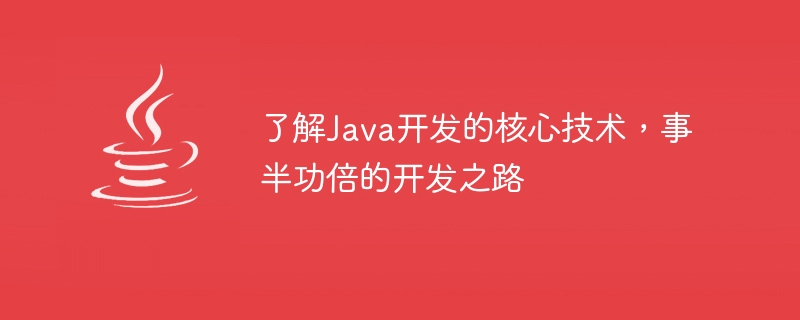

Understanding the core technology of Java development and getting twice the result with half the effort requires specific code examples
In today's software development field, Java is the most widely used programming language one. Java has the advantages of cross-platform, object-oriented, and high performance, making it the first choice for many developers. However, to get twice the result with half the effort in Java development, you need to master some core technologies. This article will introduce several important core Java development technologies and attach specific code examples.
Exception handling is a crucial aspect of Java development. Through reasonable exception handling, the stability and maintainability of the program can be improved. In Java, exceptions are handled through try-catch statements. Here is a simple example code:
try {
// 可能会引发异常的代码
int i = 1 / 0;
} catch (ArithmeticException e) {
// 异常处理代码
System.out.println("捕获到算术异常:" + e.getMessage());
}In the above code, we perform a division by zero operation, which raises an arithmetic exception. In the catch block, we obtain the details of the exception through the getMessage() method and handle it.
In addition to catching exceptions, you can also customize exception classes to achieve more precise exception handling. The following is a sample code of a custom exception class:
class MyException extends Exception {
public MyException(String message) {
super(message);
}
}By customizing the exception class, we can handle different exception situations in more detail, thus improving the readability and maintainability of the program.
Multi-threaded programming is a very important part of Java development, which can improve the efficiency and responsiveness of the program. In Java, threads can be created by inheriting the Thread class or implementing the Runnable interface. The following is a simple multi-threading sample code:
class MyThread extends Thread {
public void run() {
// 线程执行的代码
for (int i = 0; i < 10; i++) {
System.out.println(Thread.currentThread().getName() + ": " + i);
}
}
}
public class Main {
public static void main(String[] args) {
MyThread thread1 = new MyThread();
MyThread thread2 = new MyThread();
thread1.start();
thread2.start();
}
}In the above code, we create a custom thread class that inherits from the Thread class and start two threads through the start() method. A simple loop printing is performed in the run() method of each thread.
In addition to using the Thread class to create threads, you can also create threads by implementing the Runnable interface. The following is a sample code using the Runnable interface:
class MyRunnable implements Runnable {
public void run() {
// 线程执行的代码
for (int i = 0; i < 10; i++) {
System.out.println(Thread.currentThread().getName() + ": " + i);
}
}
}
public class Main {
public static void main(String[] args) {
Thread thread1 = new Thread(new MyRunnable());
Thread thread2 = new Thread(new MyRunnable());
thread1.start();
thread2.start();
}
}By implementing the Runnable interface, we can allocate tasks to threads more flexibly and achieve more efficient resource utilization.
In Java development, the collection framework is one of the basic tools. It provides a set of interfaces and classes for storing and manipulating a set of objects. Commonly used collection classes include List, Set, Map, etc. The following is a sample code using ArrayList:
import java.util.ArrayList;
public class Main {
public static void main(String[] args) {
ArrayList<String> list = new ArrayList<>();
list.add("Java");
list.add("Python");
list.add("C++");
for (String str : list) {
System.out.println(str);
}
}
}In the above code, we create an ArrayList object and add elements to the list using the add() method. Then, iterate through the list via a foreach loop and print each element.
The collection framework provides an efficient way to process and manage a set of objects, which can greatly simplify code and improve development efficiency.
In summary, understanding the core technologies of Java development is very important to improve development efficiency and code quality. This article introduces the three core technologies of exception handling, multi-threaded programming and collection framework, and gives specific code examples. I hope this article can help readers better master and apply these technologies, and improve Java development with twice the result with half the effort.
The above is the detailed content of Revealing the secrets of key Java development technologies: a way to get twice the result with half the effort. For more information, please follow other related articles on the PHP Chinese website!
 The core technologies of the big data analysis system include
The core technologies of the big data analysis system include
 What are the core technologies necessary for Java development?
What are the core technologies necessary for Java development?
 Introduction to java core technology content
Introduction to java core technology content
 What should I do if the ps temporary disk is full?
What should I do if the ps temporary disk is full?
 How to change file type in win7
How to change file type in win7
 How to delete your own works on TikTok
How to delete your own works on TikTok
 How to watch live broadcast playback records on Douyin
How to watch live broadcast playback records on Douyin
 How to change the font color in dreamweaver
How to change the font color in dreamweaver




